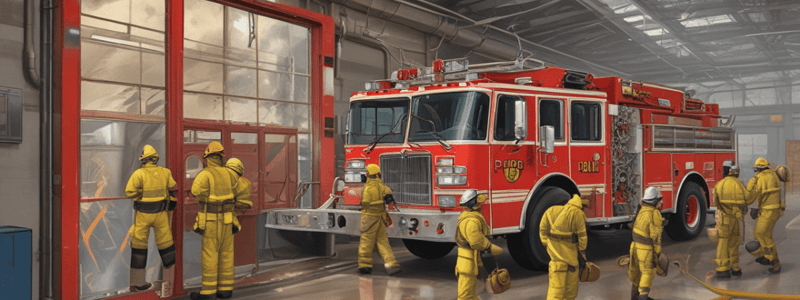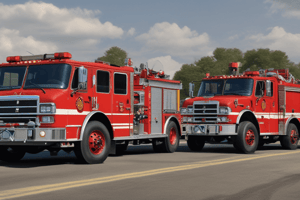Podcast
Questions and Answers
What is the flammable range of carbon monoxide?
What is the flammable range of carbon monoxide?
- 5% to 50%
- 12.5% to 74% (correct)
- 10% to 60%
- 15% to 70%
Which of the following equipment does NOT produce carbon monoxide?
Which of the following equipment does NOT produce carbon monoxide?
- Barbecue grills
- Electric fireplaces (correct)
- Gas water heaters
- Forklifts
What is the Time Weighted Average (TWA) exposure limit for carbon monoxide?
What is the Time Weighted Average (TWA) exposure limit for carbon monoxide?
- 45ppm
- 35ppm (correct)
- 50ppm
- 25ppm
Which term is NOT another name for carbon monoxide?
Which term is NOT another name for carbon monoxide?
Who should be assigned to respond when there are no reported medical signs or symptoms accompanying a CO detector alarm?
Who should be assigned to respond when there are no reported medical signs or symptoms accompanying a CO detector alarm?
What should occupants be instructed to do if there is a CO alarm with no reported symptoms?
What should occupants be instructed to do if there is a CO alarm with no reported symptoms?
What is the IDLH (Immediately Dangerous to Life or Health) level for carbon monoxide?
What is the IDLH (Immediately Dangerous to Life or Health) level for carbon monoxide?
Which response group is NOT assigned to an emergency response when there are signs or symptoms of CO poisoning?
Which response group is NOT assigned to an emergency response when there are signs or symptoms of CO poisoning?
What is the purpose of turning on the air sampling monitor during the weekly inspection?
What is the purpose of turning on the air sampling monitor during the weekly inspection?
Where should additional Mini-CO diffusion tubes be obtained from?
Where should additional Mini-CO diffusion tubes be obtained from?
How often should the air sampling monitor be checked for proper function?
How often should the air sampling monitor be checked for proper function?
What is the recommended storage condition for air sampling monitors and tubes?
What is the recommended storage condition for air sampling monitors and tubes?
What is the minimum number of Mini-CO diffusion tubes that a company should keep on hand?
What is the minimum number of Mini-CO diffusion tubes that a company should keep on hand?
What should occupants do with windows and doors when instructed to leave the building?
What should occupants do with windows and doors when instructed to leave the building?
In what situation will the alarm assignment be increased to the same response as a fire?
In what situation will the alarm assignment be increased to the same response as a fire?
What protective equipment must TFD personnel wear during a rescue in a contaminated environment?
What protective equipment must TFD personnel wear during a rescue in a contaminated environment?
Where should victims be placed after being rescued?
Where should victims be placed after being rescued?
What should be done before entering a structure or area with no rescue needed?
What should be done before entering a structure or area with no rescue needed?
What should firefighters monitor first when identifying the best entry point?
What should firefighters monitor first when identifying the best entry point?
At what CO reading should occupants be allowed to remain in place?
At what CO reading should occupants be allowed to remain in place?
What actions should be taken if CO readings are between 10 ppm and 35 ppm?
What actions should be taken if CO readings are between 10 ppm and 35 ppm?
When dispatched to a report of an odor in a neighborhood, what is the safest procedure for keeping your company's exposure to a minimum?
When dispatched to a report of an odor in a neighborhood, what is the safest procedure for keeping your company's exposure to a minimum?
Who should be notified when companies encounter odors such as ether or phenyl acetic acid?
Who should be notified when companies encounter odors such as ether or phenyl acetic acid?
What is the primary action to take when dispatched to an address with an operating drug laboratory or large amounts of chemicals?
What is the primary action to take when dispatched to an address with an operating drug laboratory or large amounts of chemicals?
What immediate action should be taken when discovering a drug lab or chemicals during a fire?
What immediate action should be taken when discovering a drug lab or chemicals during a fire?
In Situation #3, what should be done with overhaul operations in the area where chemicals are discovered?
In Situation #3, what should be done with overhaul operations in the area where chemicals are discovered?
What should be avoided when dispatched to an address with a drug lab or large amounts of chemicals according to Situation #2?
What should be avoided when dispatched to an address with a drug lab or large amounts of chemicals according to Situation #2?
When should a defensive mode be considered during a fire situation?
When should a defensive mode be considered during a fire situation?
According to Situation #1, which type of smell should prompt immediate notification to the district chief and Hazmat?
According to Situation #1, which type of smell should prompt immediate notification to the district chief and Hazmat?
What action should be taken first if the CO source cannot be identified promptly?
What action should be taken first if the CO source cannot be identified promptly?
At what CO level should the structure be ventilated to allow reoccupation?
At what CO level should the structure be ventilated to allow reoccupation?
What should be done if readings of CO are above 35ppm?
What should be done if readings of CO are above 35ppm?
What should a company officer provide if the area or structure does not have a CO detector?
What should a company officer provide if the area or structure does not have a CO detector?
What specialized equipment should Hazmat use to search for the source of CO?
What specialized equipment should Hazmat use to search for the source of CO?
Who should be called if a natural gas appliance is identified as the CO source?
Who should be called if a natural gas appliance is identified as the CO source?
What must be done after eliminating the CO source in a structure?
What must be done after eliminating the CO source in a structure?
If the source of CO cannot be identified or has been identified and mitigated, what should be the next course of action?
If the source of CO cannot be identified or has been identified and mitigated, what should be the next course of action?
Study Notes
Clandestine Drug Labs
- When responding to a report of an odor in a neighborhood or at a particular address, keep company exposure to a minimum, keep personnel clear of the area, and notify the district chief, Hazmat, the Hazmat coordinator, and the TPD Special Investigations Division (SID) if odors such as ether or phenyl acetic acid are detected.
- When responding to an address with an operating drug laboratory or large amounts of chemicals, do not change or move anything, remove non-emergency personnel, and notify the district chief, Hazmat, the Hazmat coordinator, and TPD SID.
- When responding to an address with a visible fire and a drug lab or chemicals, notify the district chief, Hazmat, the Hazmat coordinator, and TPD SID, and consider a defensive mode for that area of the building.
Carbon Monoxide Detector Response
- Carbon monoxide is a colorless, odorless, tasteless gas produced by the combustion of carbon-based fuels, and is flammable with a wide explosive range.
- Sources of carbon monoxide include automobiles, forklifts, gas-fired furnaces, gas stoves and ranges, gas water heaters, fireplaces, wood stoves, and barbecue grills.
- Important numbers for responders to know:
- Flammable range: 12.5% to 74%
- Time Weighted Average (TWA): 35ppm
- IDLH: 1200ppm
- Carbon monoxide poisoning occurs when hemoglobin in blood has a greater affinity to CO than oxygen, blocking oxygen from the blood.
Procedures for Response to a CO Detector
- If no medical signs or symptoms are reported:
- Assign a ladder company or Hazmat to a non-emergency response
- Instruct occupants to leave the building or area if possible, and close or keep windows and doors in their normal position
- If medical signs or symptoms are reported:
- Assign an engine, a ladder, Hazmat, and EMSA to an emergency response
- Instruct occupants to leave the building or area if possible, and close or keep windows and doors in their normal position
- Increase alarm assignment to the same response as that for which the occupancy receives for a fire if there are two or more victims
Rescue and Entry
- If a rescue is required, wear appropriate protective clothing including SCBA during entry and rescue in the contaminated environment
- Remove victims promptly and place them in an open and uncontaminated area for emergency medical care
- Before entering the structure or area, turn on and zero the CO detector in fresh air away from apparatus, vehicles, and the suspected contaminated area
- Monitor the outside door seal circumference, open the door slightly, and monitor the opening (starting at the floor and working slowly for 10 seconds toward the ceiling) before entering
Actions Based on CO Readings
- 0-9 ppm: Check the CO detector, inform occupants of findings and actions taken, and leave an information packet related to CO
- 10-35 ppm: Evacuate the structure or area until the source of the CO is identified and managed
- Over 35 ppm: Evacuate the structure or area, request assistance from Hazmat, and manage the incident similarly to that described for readings between 10ppm and 35ppm
Ventilation and Source Identification
- If the source of CO cannot be identified in a timely manner, keep the area or structure closed and free of fire department managed ventilation
- Request Hazmat to take part in the search for the source of CO with their specialized leak detection equipment and survey instruments
- If the source of CO is identified, shut off the appliance or eliminate the source, tag out applicable valves or controls, and ventilate the area or structure
- If a natural gas appliance is found to be the source, call ONG to assist
Reoccupation and Documentation
- Once the source of CO is eliminated, inform occupants of actions taken to remedy the situation and any needs or actions they should take to eliminate or minimize future problems
- Ventilate the area or structure to a level of less than 9ppm, survey with an instrument with data logging capabilities, and document findings and actions
- Provide a Mini-CO tube with instructions and an information packet describing CO for the occupants if the area or structure does not have a CO detector
Studying That Suits You
Use AI to generate personalized quizzes and flashcards to suit your learning preferences.
Description
Learn about the maintenance procedures for air sampling monitors and tubes in a fire department. This includes storage, weekly inspections, and bump testing with Mini-CO kits.




